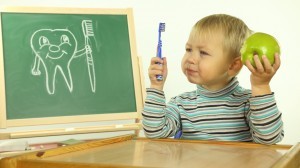We’ve already covered a few ways that teeth can grow in a bit, er, weirdly. From crooked teeth to “shark teeth”, you shouldn’t be disheartened if your smile is less than perfect, since the reality is it’s very rare to have an absolutely straight smile. A less common malady that tends to occur in children but can also happen to adults is when you have a tooth that actually looks like two teeth fused together, commonly called a double tooth. So, what’s the deal with that?
Teeth that are joined by the dentin or pulp occur in two different ways: by germination and by fusion. In germination, one tooth splits into two teeth. They remain attached together and develop together and most commonly occur in the top teeth. Fused teeth are the opposite: these are two separate teeth that have fused into one tooth. They also remain attached together and develop together, but they’re more commonly seen on the bottom teeth.
Visually, germination and fusion look virtually identical. So, how can you tell them apart? You have to count the teeth. When counting the double tooth as one tooth, if the child still has the correct number of teeth overall, then it’s a germinated tooth. If the child has one fewer teeth than he or she should, then it’s a fused tooth.
Although the condition is usually painless, it can cause spacing and crowding issues in children, which can further impact the development of the adult teeth. A double tooth will be easily identified by a dentist since it’s so visually unique, and it should be closely monitored to make sure that any potential issues are resolved before they become major problems. For instance, sometimes the adult tooth won’t grow in under the double tooth. Once the double tooth falls out, the dentist will then have to decide what to do about the space. If the double tooth was causing crowding issues, the dentist may the opt to not implant a tooth in its space in order to help bring the other teeth into better alignment. However, if there are no alignment issues and there would be an obvious gap once the double tooth falls out, an implant will likely be necessary in order to ensure the child has a normal smile.
In some cases, the dentist can reshape the double tooth by grinding and sanding it to make it appear more like a single tooth. In rarer instances, the dentist can also sometimes divide the teeth as long as they both have distinct, separate pulp chambers and roots and as long as there is enough dentin to make sure both teeth will remain strong. However, this procedure would also require a root canal for both teeth, which may expensive and painful for the patient. Both of these procedures may be worth considering if an adult has a double tooth that is obvious when talking or smiling, but might be unnecessary for children because the baby double tooth will eventually fall out on its own.
A final consideration for a double tooth is the issue of keeping it clean. Often a double tooth will have a deep indent or groove where both teeth would be split. This indent can easily trap food particles and sugars from beverages, which can, in turn, cause rapid tooth decay. Regardless of whether the double tooth belongs to an adult or child, it’s essential to ensure the tooth is brushed and flossed as thoroughly as possible to prevent tooth decay and gum disease in the area.
Double teeth are fairly uncommon but are still worth knowing about, as they can affect the overall alignment and health of the teeth around them. Although it’s often just a matter of waiting for a child’s double tooth to fall out and the permanent adult tooth to come in, understanding the unique cleaning needs and development issues the can come with the condition is essential to make sure both little and big smiles stay healthy and bright. Do you have any questions about double teeth? Let us know in the comments!








Leave a Reply